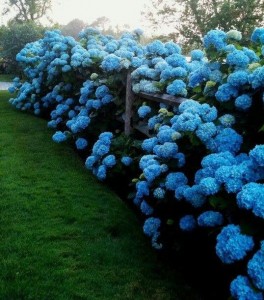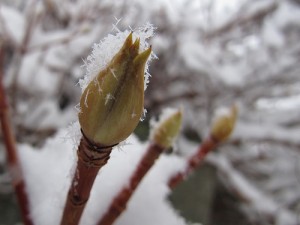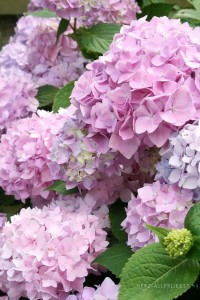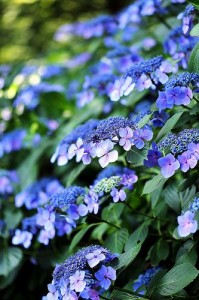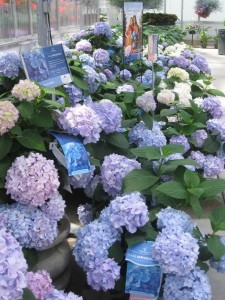Bigleaf Hydrangeas are the classic Hydrangeas that we all know and (maybe) love.These long blooming shrubs are staples of the American garden.The classic blue Hydrangea (Hydrangea macrophylla ‘Nikko Blue’) is probably the most recognized and most frequently used hydrangea in backyards across the country.
A mature and healthy ‘Nikko Blue’ Hydrangea can be a truly stunning plant, but contrary to popular belief, it is not an easy or low-maintenance shrub.The old standard Hydrangeas like ‘Nikko Blue’ are very finicky plants.They don’t like it too hot in the summer or too cold in the winter.They only produce flower heads on one year old stems, and they are not reliable flowerers.Hydrangea macrophylla also changes its flower color depending on the pH of the soil it’s planted in.So, that azure blue everyone is after may not come naturally to your hydrangea once it gets established in your garden soil.So how did this difficult shrub become so popular?Well, Hydrangea macrophylla can perform very well if it’s in a spot well suited to its needs.These spots are hard to find in your average back yard.Bigleaf Hydrangeas like sun in the summer, but not intense heat.They also cannot take very cold winters with open exposure.So, where does that leave?Coastal communities that stay temperate in the winter and cool in the summer are great spots for Bigleaf Hydrangeas.Also, sheltered spots near the foundation of the home where the Hydrangea can stay a little warmer in winter, but still get some sun in the summer.If they get too much hot summer sun, the leaves will wilt dramatically and flower heads will burn.If all this sounds like too much work for a shrub, then read on and we’ll show you how you can great Hydrangea blooms without all the fuss.
What You Need to Know to Grow Bigleaf Hydrangeas (Hydrangea macrophylla)
To make this easy, we’re going to break up the Bigleaf Hydrangeas into three different groups. These are the classic mop heads, the classic lacecaps and the rebloomers.
The Classic Mop Head Hydrangea
This group of Hydrangea macrophylla is the most common garden hydrangea that produces big round flower heads all summer. Flower heads can be blue, white, pink or any shade in between.
The most used of these is Hydrangea macrophylla ‘Nikko Blue’.This cultivar is widely considered the standard for the blue Hydrangeas.We’ve already talked a lot about this type of Hydrangea, but let’s reiterate some its important qualities.First and foremost, this is a very finicky plant.But, if you are dead set on getting those classic blue flower heads, then you will have to learn to grow the classic mop head Bigleaf Hydrangea (most likely the ‘Nikko Blue’ variety).If you are flexible with your flower color and want an easier, more reliable plant ,then you will be much better off with one of the reblooming varieties (see below) or maybe even looking at the Smooth Hydrangeas or PeeGee Hydrangeas (click to visit our articles on those plants).
So, for those of you willing to work a bit for that classic mop head look, here’s what you need to know.First, if you are in a coastal or high altitude region with cool summers and temperate winters, you are in a perfect location to grow classic mop heads.You can plant them almost anywhere in these regions.However, if you are in a Zone 6 or Zone 5 region with hot summers and cold winters, you will need to place your mop head Hydrangea in a spot sheltered from the winter wind and direct afternoon summer sun.
You will also have to avoid too much shade if you want flowers.Finding the perfect spot for your mop head hydrangea is key to your success.In Zone 5 regions, even in a good spot, you will have more success if you wrap your hydrangea in the winter.The cold winter winds can “burn” the flower buds, leaving you with no flowers the following summer. When you buy your Hydrangea, it will be labeled with a hardiness Zone (most are hardy to Zone 5 or 6).Keep in mind that this is the hardiness of the plant, not the flower buds!This means that the plant may live in very cold temperatures, but the flower buds may be killed off in most years.This is why it’s best to protect your Hydrangea from cold winter winds and temperatures.If you are experiencing consistent winter bud kill, you should probably consider moving to a different type of Hydrangea (like a reblooming Hydrangea – see below).
In hot spells during the summer, give your mop head plenty of water.They require more water than most garden shrubs.In the spring, once the leaves have started to emerge, you can clip off any branches that are dead.
If leaves are already emerging on healthy branches, then any branch without new leaf growth is likely dead and can be removed.If you are not sure, scratch the surface of the branch.If it is green underneath the outer surface, then it is alive, if not, then it is likely dead and can be removed.This type of Hydrangea produces lots of dead branches, so expect to remove some each year.Be careful about trimming healthy branches.Classic mop heads will only produce flowers on one year old branches.This means that if you trim a branch, it will not produce a flower for another year.This can become a problem if your Hydrangea gets too large.If you trim the entire plant, you will go one full year without any flowers.If you need to reduce the size of a classic mop head hydrangea, we suggest selectively trimming about half the branches one year and the other half the next year.This way you will have some flowers each year.Of course, if you are willing to sacrifice a year without flowers, go ahead and trim the entire shrub at once.This will not hurt your Hydrangea.You can trim it generously without causing problems.
All Bigleaf Hydrangeas change the color of their flower heads based on the pH of the soil they are planted in.More acidic soils produce more blue flower heads.More alkaline soil will produce more pink flower heads.This is true regardless of the cultivar you purchase.Even the famous ‘Nikko Blue’ cultivar will turn pink in alkaline soil.Keep this in mind when you are shopping for Hydrangeas.Remember the color of the bloom in the nursery may change when the Hydrangea get acclimated to your soil.If you want to influence the color of your hydrangea blooms, you can add supplements to the soil that will help you get more blue or pink flowers.Most nurseries will sell soil supplements to make your soil more acidic (blue flowers) or alkaline (pink flowers).Just ask.
The Classic Lace Cap Hydrangea
The lace cap Hydrangeas are an interesting twist on the classic mop head Hydrangeas.
Instead of large, rounded flower heads, lace caps have flat flower heads that are more subtle, but also much more interesting than mop heads.Care and maintenance of the lace cap is identical to the classic mop heads, only the flower shape is different.If you are looking for the long blooming charm of the Hydrangea, but want something different than your neighbors, try a lace cap Hydrangea.
Reblooming Bigleaf Hydrangeas
In 2004, the world of Hydrangeas changed.The “Endless Summer®” reblooming Hydrangea was introduced. As you know, Bigleaf Hydrangeas (Hydrangea macrophylla) only bloom on one year old branches.But in 2004, the Endless Summer Hydrangea became the first widely marketed Hydrangea macrophylla that could bloom on new branches and continue creating new flower buds all season long.This really changed the game for homeowners that had trouble growing or maintaining their Bigleaf Hydrangeas.
The introduction of the reblooming Hydrangea changed things in many ways.First, these reblooming Hydrangeas can be trimmed every spring and still produce flowers, so no more worrying about losing blooms on trimmed branches.Second, no more problems with cold winters killing next summers’ flower buds.If buds are killed off over the winter, new ones will form in the spring!Since the original “Endless Summer” reblooming Hydrangea was introduced, it has been extended into a series and competitors have offered other series as well.In addition to the Endless Summer® series, there is now the Forever & Ever® series and the Let’s Dance® series among others.Some of these series even include come lace cap rebloomers.
So, why would anyone plant the classic mop heads when they can plant a reblooming Hydrangea?Most gardeners have, indeed stopped planting the old classics and have switched over to reblooming varieties.But, there is one drawback to the rebloomers and that’s color.Most of the rebloomers, including the most popular, “Endless Summer” tend to have a lower intensity of color than the classics.
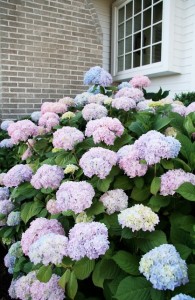
Hydrangea ‘Endless Summer’ blooms all summer but the color of the blooms are not usually as intense as the classic mop head Hydrangeas
The blues are paler and also vary more.Since the classics (like ‘Nikko Blue’) produced only one flush of flowers all at the same time, all the flowers have the same exact color.Rebloomers produce flowers throughout the season and therefore each flower will have a slightly different color.This gives the plant a more dramatic but less elegant effect.The end result is usually a paler color and also a “multicolored” effect of blooms.For some, this is just not acceptable.For others, it’s a welcome addition.You’ll have to decide for yourself which you like more.As with all Bigleaf Hydrangeas, you can attempt to get a deeper blue color on your reblooming Hydrangea by adding aluminum sulfate to the soil.
The rebloomers also tend to stop blooming in hot dry conditions.So, the rebloomers are tending to bemore popular in northern gardens where winter bud kill is a problem and less popular in the south.


